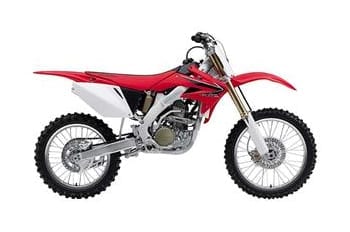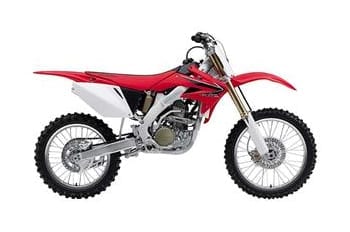Honda CRF250R
By TMX Archives on 27th Sep 07

The natural starting point was the CRF250R and in recent years I feel it has been playing catch-up a bit.
It seemed to make great strides forward in its first couple of years, and its handling in particular has always been right-up there at the top of the class, but its motor has never been the strongest and in the past couple of seasons it has been caught and passed by more than one of its rivals.
For 2008 though, it seems Honda has really pushed the boat out to put the CRF250R right back up there.
Honda likes to state that it is always one step ahead of the pack and they are certainly the first manufacturer to fit a steering damper on a motocross bike from the crate.
Yes that's right, the 2008 Honda range comes equip-ped with the Honda Progressive Steering Damper (HPSD) system that has been in use on the factory bikes for a number of years. It's the big USP of the CRF models for 2008 and it looks real factory too.
It mounts behind the number plate so you can't actually see it unless you have a good nosey or you take the number plate off, but on the track it seemed to work very well indeed.
For those of you who don't understand how it works, I will try and explain. When you're going down a fast straight or through a fast corner with a lot of high speed bumps and you are getting tired it is quite normal for the front-end to push and shake from side to side unless you have arms like Popeye. So, Honda has fitted the damper to reduce this phemonenon. It's basically like a mini shock-absorber for the steering system.
When you are in the paddock and you turn the bars slowly it doesn't seem to do that much but when you shake them back and forth quickly you can really feel the damper working so, when you're on the track, it really becomes noticable.
It smoothens everything out, particularly on the fast choppy stuff and if you really go in to a corner hard, and the bumps and lumps that would ordinarily push the front-end away from you or cause you to get a bit of tank-slapper on, have noticeably less effect on the bike, and if you get out of shape the damper starts to work overtime, hence less scary moments on the track.
All this contributes to a bike that feels significantly more planted and stable, particularly at higher speeds, and, importantly, takes less energy to control, thus making it and easier ride all round.
What is surprising is that this has been achieved despite the fact that the front-end has been steepened by 2mm. This may not sound a lot, but it has a huge impact on the geometry of a motorcycle and the result is a bike with a 2mm shorter wheelbase and sharper steering angle. In the past, this would have resulted in a bike that turned faster but at the sacrifice of overall handling and stability, However, because of the addition of the steering damper, Honda has achieved the feat of getting a bike to turn faster and sharper whilst actually im-proving overall bike stability.
It's a big achievement and boosts rider confidence in the bike significantly, and I'm sure it won't be long before all the other Japanese manufacturers will be fitting one too. When you think about it really, it's a bit of no-brainer, and does make you wonder why steering damper technology hasn't been applied before.
As a result, the overall handling of the CRF250R was pretty damn good and a step-up again from what was already a sweet handling bike. It cornered very smoothly and always felt planted entering and exiting, the seating position felt good and I found the bike was very easy to throw around. In fact, I didn't get out of shape all day which isn't bad for me! Although I did have a bit of a scary moment over the finish line tabletop but it is about 200 foot long - slight exaggeration I know, but it is big.
The suspension was really good too, especially for slightly heavier riders than your usually featherweight schoolie. The HSPD system allowed Honda to run slightly harder settings front and rear, and, while still very plush and supple off the bottom of the stroke, they were a bit firmer, which made a big difference for me and will for heavier riders, as I wasn't ploughing through the stroke as quickly.
Ok, so the HPSD unit is great, onto the other stuff.
The overall look of the bike is pretty similar to last year but with the ground-breaking (yeah right) new graphics as always, and slightly modified rear fender and a new left side engine guard.
Power wise, the 2008 CRF250R was very impressive too. Although very useable, it's not exactly been the strongest motor out there over the past few years, but the 2008 model seems much stronger than last year's bike which is great news.
Most noticeable was a much improved bottom-end. I found it to be very responsive out of the turns and a real pleasure to ride, which is probably down to the new piston and 13.1:1 compression ratio as well as the new cylinder porting and lighter valve components that help it rev out that bit further to 13,500 rpm. All the way through the rev-range though, the bike felt stronger and more responsive which is impressive.
To sum up, I think Honda are going to be back at the front of the pack with their 2008 CRF250R, and cleverly, on Honda's behalf, I don't necessarily think it's be-cause it is loads better than its rivals, it's not, although it is a contender for best all-round bike in its class. I think it's going to be down to one little item, the HPSD steering damper. We all like to have the latest technology and the Honda Progressive Steering Damper is definitely going to turn some heads in the paddock.
Specification:
2008 model Honda CRF250R/ CRF450R
ENGINE
Type: Liquid-cooled four-valve SOHC single four-stroke
Displacement: 249.4/ 449 cc
Bore x Stroke: 78 x 52.2 mm/ 96 x 62.1 mm
Compression Ratio: 13.1 : 1/ 12 : 1
Max Power: 32kW @11,000 rpm/ 37.8kW @ 9,000 rpm
Max Torque: 29.3Nm @ 8,500 rpm/ 46.9Nm @ 7,000 rpm
Carburation: 40 mm (with TPS)/ 41 mm Keihin FCR flat-slide carburettor
Ignition: Computer-controlled digital capacitor discharge with electronic advance
Starter: Primary kick
Transmission: 5-speed
Final Drive: #520 roller chain
CHASSIS
Type: Semi-double cradle, aluminium twin-spar
SUSPENSION
Front: 47mm Showa inverted leading-axle twin-chamber cartridge-type telescopic fork with 16-step adjustable compresion and rebound damping
Travel: 315 mm at axle
Rear: Pro-Link with Showa damper, adjustable low-speed (13-step) and high-speed (3.5- turn) compression and 17-step rebound damping
Travel: 313 mm/ 320 mm at axle
WHEELS
Front: 21 x 1.60 aluminium rim/ wire spoke
Rear: 19 x 1.85/ 19 x 2.15 aluminium rim/ wire spoke
TYRES
Front: 80/100 21 (51M)
Rear: 100/90 19 (57M)/ 110/90 19 (62M)
BRAKES
Front: 240 mm hydraulic disc with dual-piston calliper and sintered metal pads
Rear: 240 mm hydraulic disc with single-piston
DIMENSIONS
Length: 2,170 mm/ 2,189 mm
Width: 827 mm/ 825 mm
Height: 1,277 mm/ 1,283 mm
Wheelbase: 1,477 mm/ 1,489 mm
Seat Height: 965 mm/ 955 mm
Ground Clearance: 362 mm/ 340 mm
Weight: 101.2 kg/ 109 kg
Fuel Capacity: 7.3 litres/ 7.2 litres

